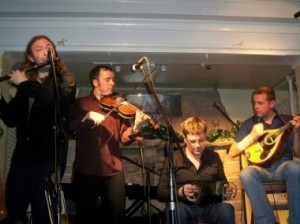If you’re a dancer, you’ll love the Innisfree Céilí Band’s “Music of North Connacht.” And if you don’t dance, you’ll wish you did. Well, you can still tap your toes.
The always busy Teada fiddler Oisin Mac Diarmada is the driving force behind the Innisfree Céilí Band. (Thanks, Oisin, for providing the CD.) There are three Mac Diarmadas in the band in all, also including Cormac on fiddle and Maire on flute.
Innisfree won the 2008 All-Ireland Senior Céilí Band competition. It’s easy to see why. In its 12 tracks, “Music of North Connacht” seeks to encapsulate the musical traditions of counties Sligo, Roscommon and Leitrim. It succeeds brilliantly.
In his liner notes, MacDiarmada pays tribute to the flute and fiddle pairings North Connacht is known for and he honors the memory of those superb musicians, such as South Sligo’s Michael Coleman and James Morrison, whose early crackling and hissing 78s captured and preserved the tradition.
Innisfree’s 11 musicians—three fiddles, four flutes, two accordions, piano and drums—play with huge energy, discipline and clarity.
The CD opens with an energetic set of reels, “The Real Blackthorn Stick” and “Trim the Velvet,”and it sets a driving pace for all that follows.
I’m a big fan of the fourth track, a set of marches (“O Domhnaill Abu” and the venerable “Jamesy Gannon’s.” For whatever reason, it put me in mind of a Friday night céilí at the Philadelphia Irish Center. That, and I just like “Jamesy Gannon’s.”
Track nine, is another standout, a set of jigs featuring “Geese in the Bog” and “I Was Born for Sport.”
I have to give props to the drummer, Sligo’s Daragh Kelly. Every céilí band needs a living, breathing human metronome, and Kelly fits the bill.
I also greatly appreciated the detailed little notes on the track list. Each track provides an encapsulated history or the tunes and where they came from.
If you’d like to acquire these splendid tunes for yourself, the CD is supposed to be available at www.innisfreeceiliband.ie, but when I checked, the site wasn’t up yet. That’s how new this CD is. Indeed, the CD release party is scheduled for tomorrow, October 17, in Gurteen, County Sligo. Keep checking.
You can also visit their Facebook page.


